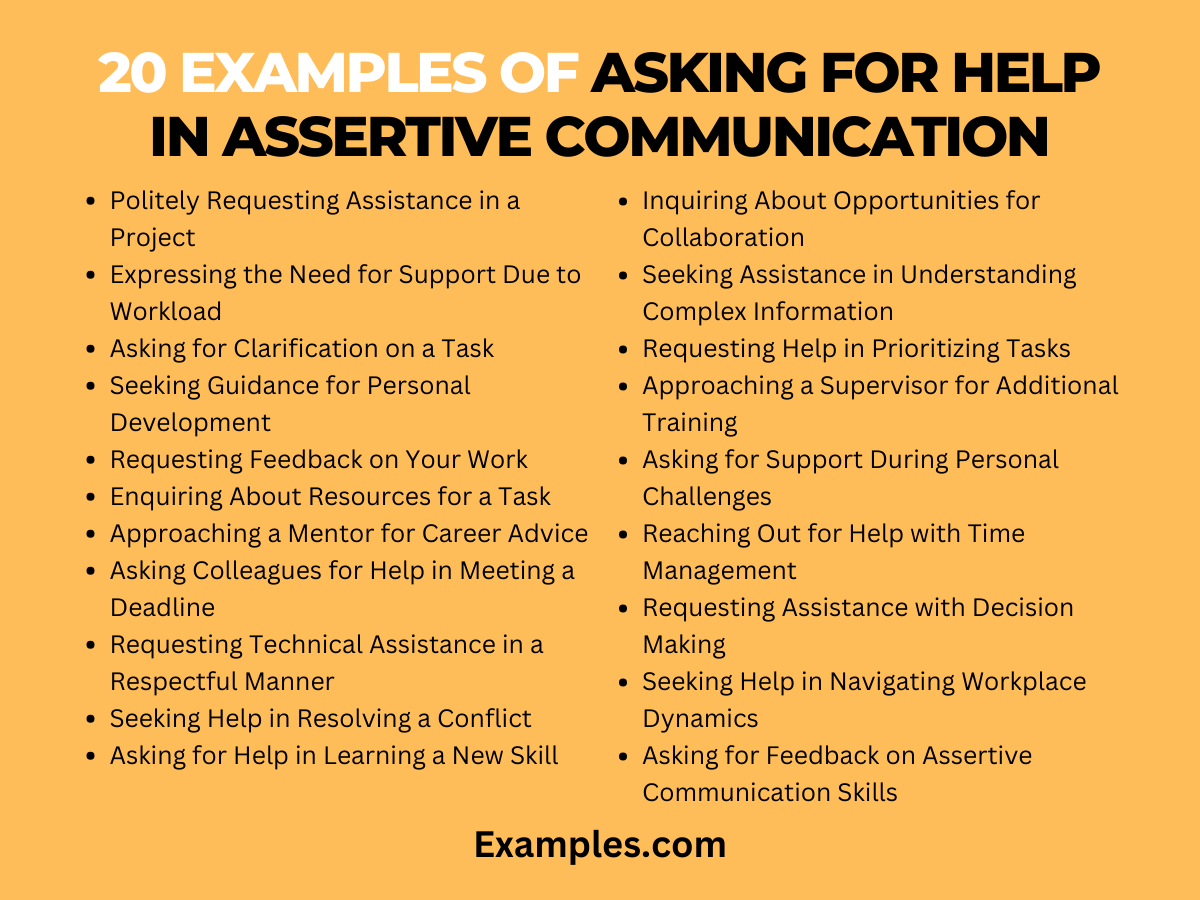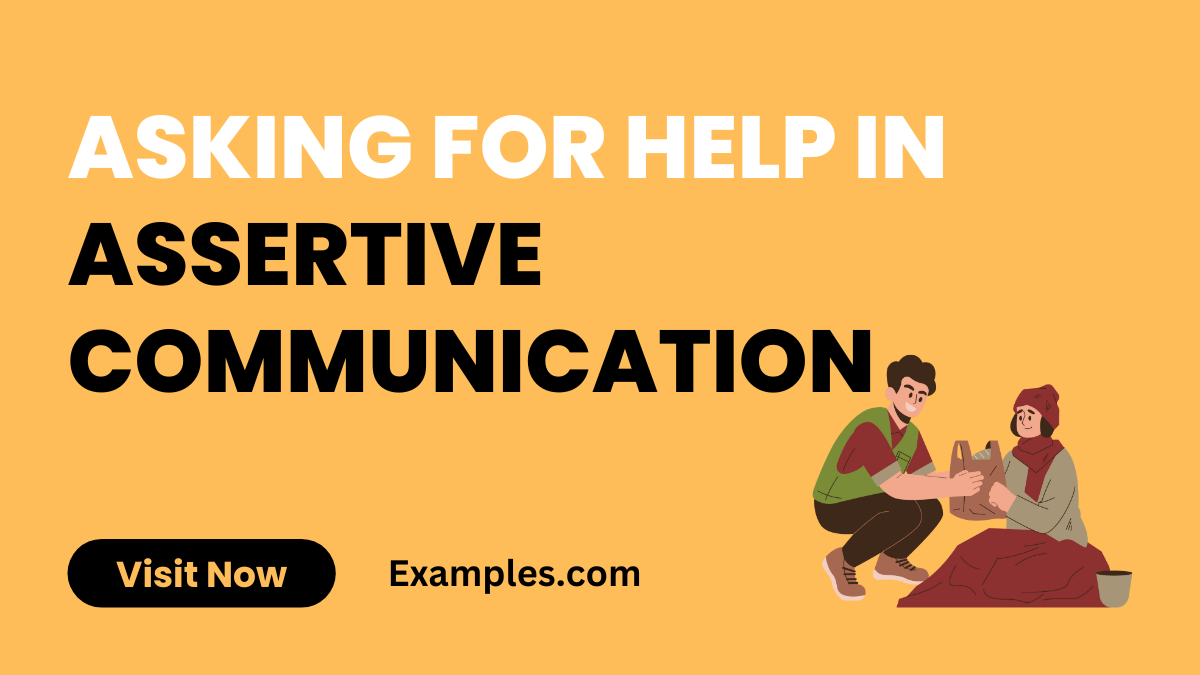Asking for Help in Assertive Communication
Navigating the complexities of asking for assistance can be challenging, but with the right approach, it becomes a skill that strengthens relationships and workplace dynamics. This comprehensive guide on Asking for Help in Assertive Communication offers practical strategies, enriched with real-life oral Communication Examples. It delves into the art of expressing needs confidently and respectfully, using Assertive Communication Techniques. Enhance your communication repertoire with our expert advice, perfect for professionals and individuals alike, seeking to communicate more effectively and assertively.
20 Examples of Asking for Help in Assertive Communication
In the realm of effective interpersonal skills, knowing how to ask for help using assertive communication is vital. This guide presents “20 Examples of Asking for Help in Assertive Communication,” each with a clear, practical explanation. These examples demonstrate how to request assistance confidently and respectfully, employing key assertive communication skills like empathy, clear expression, and emotional control. Ideal for both personal and professional contexts, these strategies ensure that your requests are understood and well-received, fostering collaborative and supportive relationships.

- Politely Requesting Assistance in a Project: “I’m working on this project and could use your expertise. Could you help me with this part?” Demonstrates respect for the other’s skills while clearly stating your need.
- Expressing the Need for Support Due to Workload: “I’m currently overwhelmed with tasks. Can you assist me with this report?” Shows vulnerability and a clear expression of your current situation.
- Asking for Clarification on a Task: “I want to ensure I do this right. Can you explain this process to me?” Indicates a desire for accuracy and understanding in your work.
- Seeking Guidance for Personal Development: “I admire your skills in [area]. Could you guide me on how to improve?” Shows respect and a willingness to learn from others.
- Requesting Feedback on Your Work: “I value your opinion. Can you provide feedback on my recent project?” Demonstrates openness to constructive feedback and personal growth.
- Enquiring About Resources for a Task: “Do you know where I can find resources for this project?” A straightforward request that shows initiative and resourcefulness.
- Approaching a Mentor for Career Advice: “I’m considering some career changes. Could we discuss your insights on this?” Indicates respect for their experience and a desire for informed decision-making.
- Asking Colleagues for Help in Meeting a Deadline: “I’m struggling to meet this deadline. Can anyone assist me for a short time?” Directly states your need while opening the door for assistance.
- Requesting Technical Assistance in a Respectful Manner: “I’m not well-versed in this software. Could you help me understand it better?” Acknowledges a gap in your knowledge and respectfully seeks help.
- Seeking Help in Resolving a Conflict: “I’m finding it challenging to resolve this issue. Can you provide some advice?” Demonstrates emotional control and a solution-oriented approach.
- Asking for Help in Learning a New Skill: “I’m eager to learn about [skill]. Can you show me the basics?” Shows enthusiasm and a proactive approach to learning.
- Inquiring About Opportunities for Collaboration: “Your expertise could really benefit my current project. Would you be interested in collaborating?” Indicates respect for their skills and a desire for mutual benefit.
- Seeking Assistance in Understanding Complex Information: “I’m having trouble grasping this concept. Can you help break it down for me?” Shows a desire for clarity and understanding.
- Requesting Help in Prioritizing Tasks: “I’m not sure how to prioritize these tasks. Can you offer some guidance?” Indicates a willingness to improve in task management.
- Approaching a Supervisor for Additional Training: “I think additional training in [area] would help me. Can we discuss this possibility?” Shows initiative and a commitment to professional growth.
- Asking for Support During Personal Challenges: “I’m facing some personal challenges that are affecting my work. Can we talk about possible support measures?” Shows vulnerability and trust in a respectful manner.
- Reaching Out for Help with Time Management: “I’m struggling with managing my time effectively. Do you have any tips or strategies?” Indicates a proactive stance towards personal development.
- Requesting Assistance with Decision Making: “I’m torn between two options. Can you help me weigh the pros and cons?” Shows respect for their judgment and decision-making skills.
- Seeking Help in Navigating Workplace Dynamics: “I’m new here and trying to understand the team dynamics. Can you offer some insights?” Demonstrates a desire to integrate effectively into the team.
- Asking for Feedback on Assertive Communication Skills: “I’m working on my assertive communication. Can you give me feedback on how I’m doing?” Shows dedication to personal development and effective communication.
Strategies for Asking for Help in Assertive Communication
In the art of assertive communication, requesting help is a nuanced skill. This guide explores “Strategies for Asking for Help in Assertive Communication,” offering 10 distinct examples, each accompanied by a brief explanation. These strategies demonstrate how to effectively communicate your needs while maintaining a balance of assertiveness and respect. From the workplace to personal interactions, these examples will empower you to ask for assistance confidently, enhancing your communication skills and fostering positive relationships.

- Initiating a Conversation for Help with Confidence: “I’ve been working on this issue and could use some guidance. Can we discuss it?” Showcases initiating a request confidently while indicating willingness to collaborate.
- Utilizing ‘I’ Statements to Express Need for Assistance: “I’m finding this task challenging and would appreciate your help.” Using ‘I’ statements to express your needs directly and personally.
- Expressing Specific Needs in a Team Setting: “In our project, I need assistance with X. Can someone help?” Directly stating specific needs in a team environment fosters clarity and effective collaboration.
- Formulating a Request with a Positive Attitude: “I’m excited about learning this new skill. Would you be willing to teach me?” Exhibits enthusiasm and a positive approach towards learning from others.
- Seeking Expertise in a Respectful Manner: “You have great expertise in this area. Can I seek your advice on this matter?” Acknowledges the other person’s expertise and politely requests their input.
- Proposing a Mutual Benefit in Asking for Help: “If you could help me with this, I’d be happy to assist you with Y in return.” Suggesting a mutual exchange of assistance, fostering a reciprocal relationship.
- Addressing the Importance of the Request: “This is important for the project’s success. Can you support me in this task?” Highlights the significance of the request, stressing its importance.
- Building Rapport Before Making a Request: “I’ve noticed your success in X. I’m currently facing a similar challenge. Can we talk about it?” Establishes a connection based on mutual interests before asking for help.
- Demonstrating Openness to Various Solutions: “I’m open to suggestions on how to approach this. What do you think?” Indicates flexibility and openness to different ideas and solutions.
- Reaffirming Appreciation Post-Assistance: “Your help was invaluable. Thank you for your support and guidance.” Expressing gratitude after receiving help, which strengthens relationships and rapport.
Overcoming Barriers to Asking for Help with Assertive Communication Techniques
Addressing the challenges in seeking assistance, “Overcoming Barriers to Asking for Help with Assertive Communication Techniques” offers a detailed guide with 10 unique examples. Each example provides insights into how assertive communication can break down barriers, whether they stem from personal hesitation, cultural norms, or workplace dynamics. These techniques are designed to empower individuals to seek help confidently, fostering a culture of support and open communication.
- Breaking Through Self-Doubt: “I need to overcome this hurdle. Can you assist me?” Demonstrates self-awareness and the courage to seek help despite personal doubts.
- Overcoming Fear of Rejection: “I understand if you’re busy, but could you help me with this?” Addresses potential rejection upfront, making it easier to accept any outcome.
- Tackling the Perception of Weakness: “Asking for help isn’t my strong suit, but I value your input on this.” Acknowledges personal challenges in seeking help, changing the narrative around vulnerability.
- Dealing with Cultural Barriers in Help-Seeking: “In our culture, asking for help isn’t common, but I believe in teamwork. Can you assist me?” Addresses cultural norms while advocating for collaborative efforts.
- Communicating Needs Amidst High Expectations: “Despite the high expectations, I require assistance to meet these goals. Can we discuss this?” Expresses the need for help in environments with high expectations.
- Assertively Requesting Help in a Senior Role: “Even in my position, I need guidance sometimes. Could I get your thoughts on this?” Demonstrates that seeking help is applicable at all levels, including senior roles.
- Challenging Gender Stereotypes in Asking for Assistance: “I want to defy stereotypes and openly ask for help with this. Can you support me?” Addresses and challenges gender norms related to seeking help.
- Navigating Hierarchical Obstacles: “I respect the hierarchy, but I believe your expertise is what I need right now. Can you help?” Directly addresses and navigates hierarchical challenges in seeking assistance.
- Framing the Request as a Learning Opportunity: “I see this as a chance to learn from the best. Would you guide me on this?” Positions the request for help as an opportunity for learning and growth.
- Reassuring the Helper of Your Efforts: “I’ve tried X and Y, but I’m still struggling. Can you provide some insight?” Shows that you have made efforts to solve the problem before asking for help.
Effective Techniques in Asking for Help in Assertive Communication
Discovering effective techniques in asking for help through assertive communication is key to building strong, collaborative relationships. This guide emphasizes the importance of clear, confident communication in seeking assistance. Each of the ten examples provided illustrates a unique, practical approach to requesting help, integrating assertive communication skills and empathetic listening. These examples serve as a blueprint for effectively and respectfully articulating your needs, ensuring your requests are not only heard but also positively received and acted upon.

- Utilizing ‘I’ Statements to Express Need for Help: “I’m finding it challenging to complete this task alone. Could you assist me?” Using ‘I’ statements helps in expressing your needs directly and personally.
- Expressing Specific Needs Clearly: “I need help with understanding this client’s requirements. Can we discuss it?” Clearly stating what you need help with ensures precise assistance.
- Phrasing Requests as Opportunities for Others: “Would you like to collaborate on this project? Your expertise would be invaluable.” This approach makes the request mutually beneficial.
- Communicating the Importance of Assistance: “Your assistance with this task is crucial for its timely completion. Can you help?” Expressing the significance of help underscores its importance.
- Reaching Out for Emotional Support Assertively: “I’m feeling overwhelmed and could use someone to talk to. Are you available?” Asking for emotional support assertively respects both parties’ boundaries.
- Soliciting Opinions or Advice Confidently: “I value your perspective. What do you think is the best approach here?” Seeking advice confidently shows respect for the other’s opinion.
- Requesting Help in Skill Enhancement: “I admire your proficiency in [skill]. Could you give me some tips to improve?” Shows eagerness to learn and self-improve.
- Inviting Participation in Problem-Solving: “I’m trying to solve this issue. Could we brainstorm solutions together?” Encourages collaborative problem-solving and values the other’s input.
- Assertively Asking for Resource Sharing: “I could really use [resource] for my project. Can we arrange for it to be shared?” Directly requesting resources needed for a task.
- Seeking Guidance in Career Progression: “I’m planning my career path and would appreciate your insights. Can we set up a meeting to discuss?” Indicates a proactive approach to career development and respect for the mentor’s expertise.
How Can Assertive Communication Enhance the Effectiveness of Asking for Help?
Assertive communication is a powerful tool in enhancing the effectiveness of asking for help, striking a balance between passivity and aggression. It involves expressing your needs clearly and respectfully, without infringing on the rights of others. Here’s how assertive communication can make a difference:
- Clarity and Precision in Requests: Assertive communication enables you to articulate your needs clearly, avoiding misunderstandings. By being specific about what you need, the likelihood of receiving appropriate help increases.
- Building Respect and Trust: When you communicate assertively, you show respect for both yourself and the person you are asking for help. This fosters trust and openness in relationships, making others more willing to assist.
- Encouraging Mutual Understanding: Through active listening and empathetic responses, assertive communication promotes a deeper understanding of each other’s needs and capabilities, leading to more effective assistance.
- Reducing Reluctance to Ask for Help: Many people hesitate to ask for help due to fear of appearing weak or incompetent. Assertive communication, with its emphasis on honesty and respect, helps overcome these barriers.
- Creating a Positive Environment: By communicating needs in a positive and confident manner, assertive communication creates an encouraging environment where seeking help is normalized and valued.
- Preventing Conflicts and Resentment: Assertive communication helps in expressing needs without aggression or passivity, reducing potential conflicts and feelings of resentment from either party.
By enhancing these aspects, assertive communication not only improves the process of asking for help but also strengthens overall interpersonal dynamics.
What Are Common Challenges Faced When Asking for Help Assertively?
Despite its benefits, assertive communication in asking for help can present several challenges. Being aware of these challenges is the first step in overcoming them:
- Fear of Being Perceived as Weak or Incompetent: Many individuals fear that asking for help might make them appear less capable, affecting their self-esteem and workplace standing.
- Difficulty in Expressing Needs Clearly: Some people struggle to articulate their needs effectively, which can lead to miscommunication and unmet expectations.
- Worrying About Imposing on Others: There’s often a concern that asking for help might burden others, especially in high-pressure environments like the workplace.
- Navigating Power Dynamics: In hierarchical settings, asking for help from superiors or subordinates can be tricky, as it involves navigating power dynamics and professional boundaries.
- Cultural and Personal Barriers: Cultural backgrounds and personal beliefs can influence one’s approach to communication, making assertive communication challenging for some.
- Maintaining the Right Tone and Approach: Finding the right balance in tone to avoid seeming either too aggressive or too submissive can be a delicate task.



